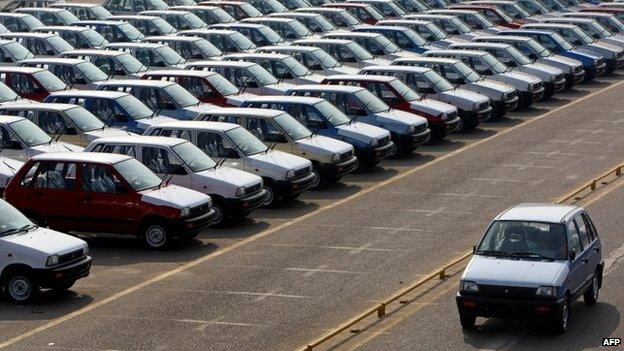Maruti 800: India's iconic car bows out
- Published

More than two million units of the Maruti 800 have been sold since 1983
The production of one of India's most iconic and best-selling cars, Maruti 800, has been stopped in favour of more modern vehicles. The Maruti 800 was more than a car - it symbolised dreams, aspirations and status for an entire generation of Indians. The BBC Monitoring's Vikas Pandey looks back at the history of this "little car".
Mohit Sharma goes down memory lane when I tell him that the Maruti 800's production has been stopped by its manufacturer Maruti Suzuki India Limited.
It was the Delhi-based property dealer's first car and it soon became an "important part" of his family.
"It soothes the soul when I remember family holidays and picnics - the car was always there. I took pride in owning the car back in 1994 because not many people had it. It was my corner, my space in the world," he says.
Mr Sharma bought other cars in the last decade, but could "never match the feeling of owning the Maruti 800".
Cult status
So how did this small car get a cult status in India?
The answer lies in the early years of its production and sales.
India was a closed economy in the early 1980s and buying a car was a distant dream even for relatively wealthy people.
Two other cars - the Hindustan Motors' Ambassador and Premier Padmini - were available at the time but were bulky and expensive.
The 800cc Maruti car, produced by the Indian government-backed Maruti Udyog Limited and Japanese firm Suzuki, entered the market in December 1983 and immediately caught the attention of the country. It was priced at 52,500 rupees ($843; £507).
A generation of Indians, including legendary cricketer Sachin Tendulkar, were in awe of India's "little car".
The batsman, who owns a fleet of luxury cars today, dreamt of buying the Maruti 800 in his early years.

The car became popular among taxi drivers in the past few years
In a TV interview last year, he said the Maruti was his first car and vividly remembered the thrill of buying and driving it in Mumbai.
The car's popularity grew by leaps and bounds after India started opening its economy in 1991. As the middle class grew, so did their aspiration of buying a car.
The Maruti 800 perfectly fit the bill - it was small, relatively cheap and sparked a feeling of pride.
It revolutionised India's streets and happily co-existed among scooters, motorbikes and sometimes even horse carts.
An editorial in the Deccan Herald, external perfectly explains why this car became a phenomenon and started the Maruti era.
"When it was introduced in the country in 1983, and in the decades since then it brought down cars from the realm of luxury to within the reach of large numbers of people," it says.
Goodwill
The Asian Age, external remembers how this small car took on the might of established car companies in India.
"The world's technology had first come in a tiny package to India, but it quickly sounded the death knell of the monopoly of locally produced cars based on ancient technologies sustained by the socialist ideologies of the time," it says.
Maruti Suzuki India Limited, which is an independent firm now, still relies heavily on the goodwill it generated through the Maruti 800.
The firm reinvented the car several times until 2010 to keep up with the fast-changing times in India. But it's the same pace of time that has finally sounded the death knell for the car.
Today's Indian automobile market is a crowded place with many major international firms competing to woo buyers.
The tiny car struggled to keep its market share and the firm finally decided to call curtains on this historic machine in January 2014.
But will this be the end of the Maruti 800's history? Mr Sharma's answer is no.
"The car will always keep its vintage value. Just keep it in good shape and you will be able to take it to any vintage car rally in the coming years," he says.
BBC Monitoring, external reports and analyses news from TV, radio, web and print media around the world. For more reports from BBC Monitoring, click here. You can follow BBC Monitoring on Twitter , externaland Facebook, external.